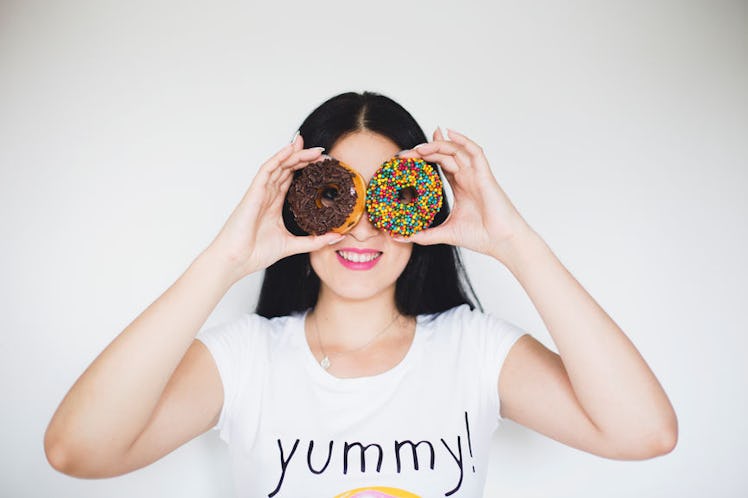
Experts Reveal How To Bounce Back From A Sugar Crash When All You Want To Do Is Sleep
If you ever watched Willy Wonka and the Chocolate Factory as a kid (the Gene Wilder version, duh), then you probably thought the sugar haven was a dream come true. What could be better than a chocolate river, lickable sugary wallpaper, and everlasting gobstoppers? As appealing as the colorful sweets are to look at on TV, though, in reality, going to town on a mountain of candy is likely to lead to an energy crash. However, this doesn't mean you have to say goodbye to your beloved Ben & Jerry's. Knowing how to bounce back from a sugar crash will help you manage the aftermath of spectacular desserts so that you don't feel like passing out as soon as the sugar high wears off.
So what's actually happening inside your body during a sugar crash? According to Reader's Digest, as sugar floods your bloodstream, your pancreas releases insulin to control blood glucose levels. This glucose is then rapidly digested, and your spiked dopamine (aka a neurotransmitter that regulates feelings of pleasure) and blood sugar levels fall quickly. In other words, the high sugar levels basically throw your body's balance totally out of whack.
According to Sydney Greene, a registered dietitian at Middleberg Nutrition, there's no magic number of sugar grams that will lead to a guaranteed crash. "Someone's activity level, hormone production, and the type of sugar they're consuming all contribute to blood sugar peaks and valleys," she explains to Elite Daily over email. But a pretty good rule of thumb is sticking to foods with only about four to eight grams of added sugar, Greene recommends.
Trial and error are ultimately your best bet to figuring out what causes your body to have a sugar crash, though, says registered dietitian, nutritionist and Arivale coach Ginger Hultin. "Each person should listen to their body to determine what works best for them," she tells Elite Daily. "Individualizing is so critical. Each person is very different."
And while the same goes for finding the best ways to bounce back from a sugar crash, here are a few general guidelines to follow the next time you're riding the struggle bus after treating yourself to a box of donuts.
Steer Clear Of Alcohol For A Bit
So many delicious desserts go well with a nice drink, IMO. Red wine with dark chocolate is pretty much the best heart-healthy and delicious duo. But if you're enjoying a sweet treat at the end of the night, try to choose between that and your alcoholic beverage, recommends Eudene Harry, M.D., a board-certified doctor in emergency medicine and holistic integrative medicine "Limit your alcohol consumption with dessert, as this could make recovery and your sugar crash symptoms feel worse," she tells Elite Daily over email.
Go Caffeine-Free
A sugar crash can make you feel like taking a marathon nap in the middle of the day. If you want to recover quickly from a sugar rush, you might think you need to reach for a cup of coffee or even an energy drink to give you a quick boost. But according to Dr. Harry, this could make matters even worse. "For many people, this could lead to a spike in adrenaline and cortisol, our stress hormones," she explains. Instead, reach for an unsweetened, caffeine-free drink like water or hot tea to keep you hydrated.
Reach For All Of The Carbs
If the way to your heart is through a soft, pillowy piece of bread, girl, I can totally relate. But if you're looking to recover from a sugar crash, reach for different kind of carb to get back on track. According to Livestrong, "you need a rapidly absorbing form of carbohydrate, also known as a simple carb," when you're trying to recover from a sugar crash. The outlet recommends eating 15 to 30 grams of "fast-digesting carbs" when you're feeling that weird, sugary haze. Unlike your favorite donut or croissant, simple carbs can be found in things like fruits and milk products.
Eat Plenty Of Real Food
According to Dr. Harry, it's better for your insulin levels if you have your dessert with a substantial meal, rather than on an empty stomach. "Balancing your meal with something that is slower to digest, such as a high-protein food with high-fiber vegetables, can help slow the release of insulin," she explains. In other words, after enjoying your afternoon chocolate croissant, fix yourself a quality dinner of chicken and vegetables to balance it all out.
Don't Sweat It Too Much
Look, at the end of the day, the most important thing to remember when enjoying a spectacular dessert is just that: to enjoy it. Greene suggests sharing your tasty treats with friends and truly savoring each bite. "When it comes time for dessert," she says, "enjoy it with someone, and eat it mindfully — slow down while eating and enjoy."